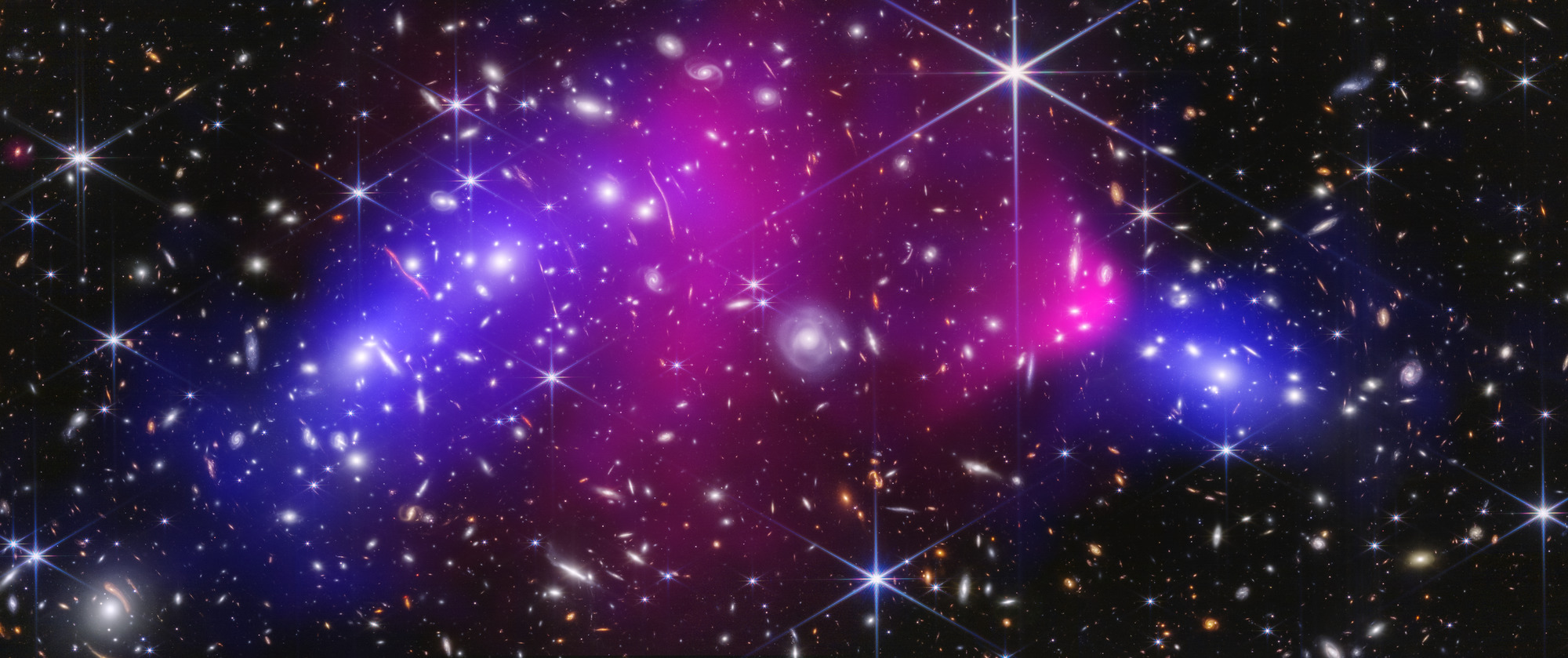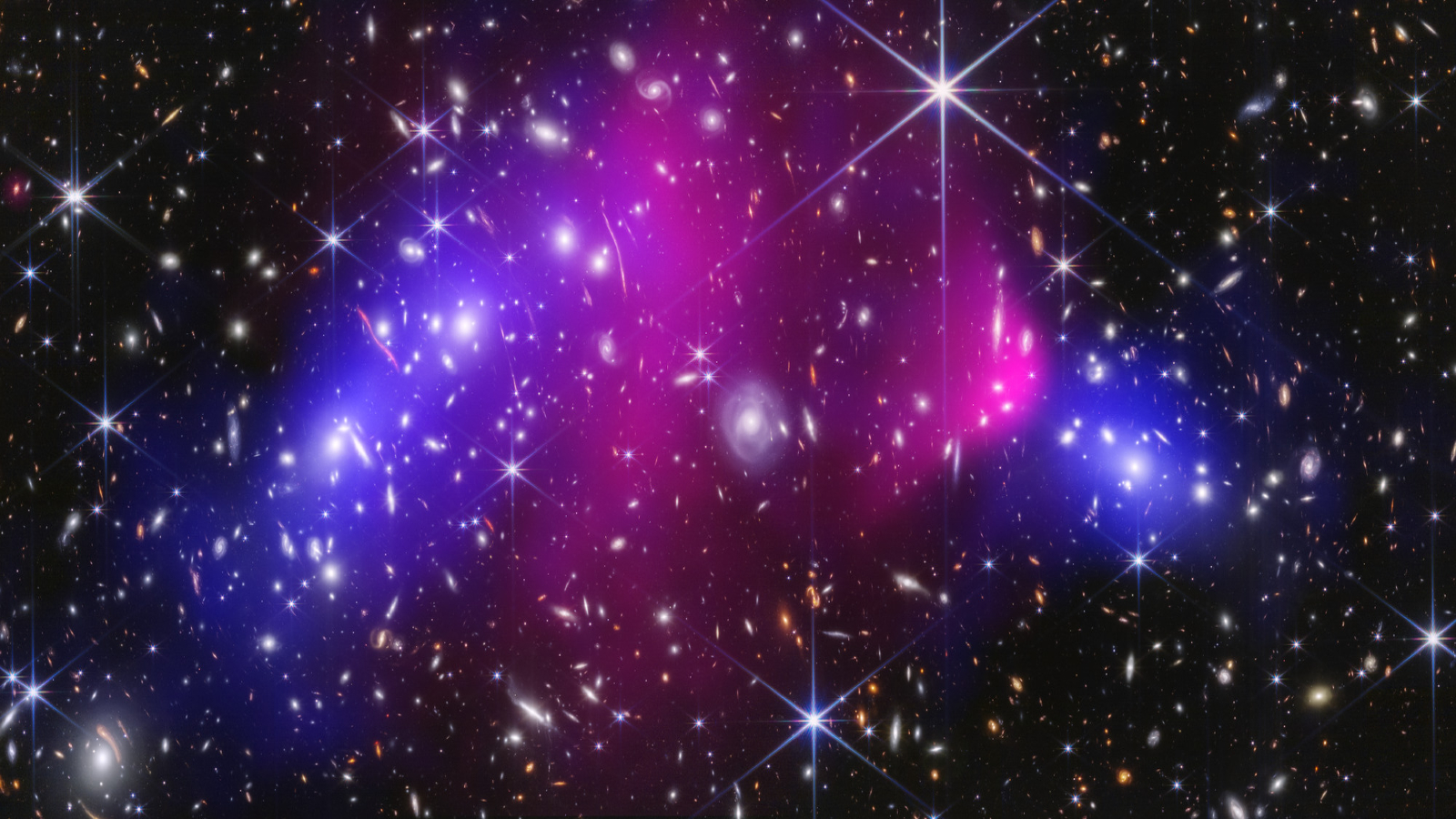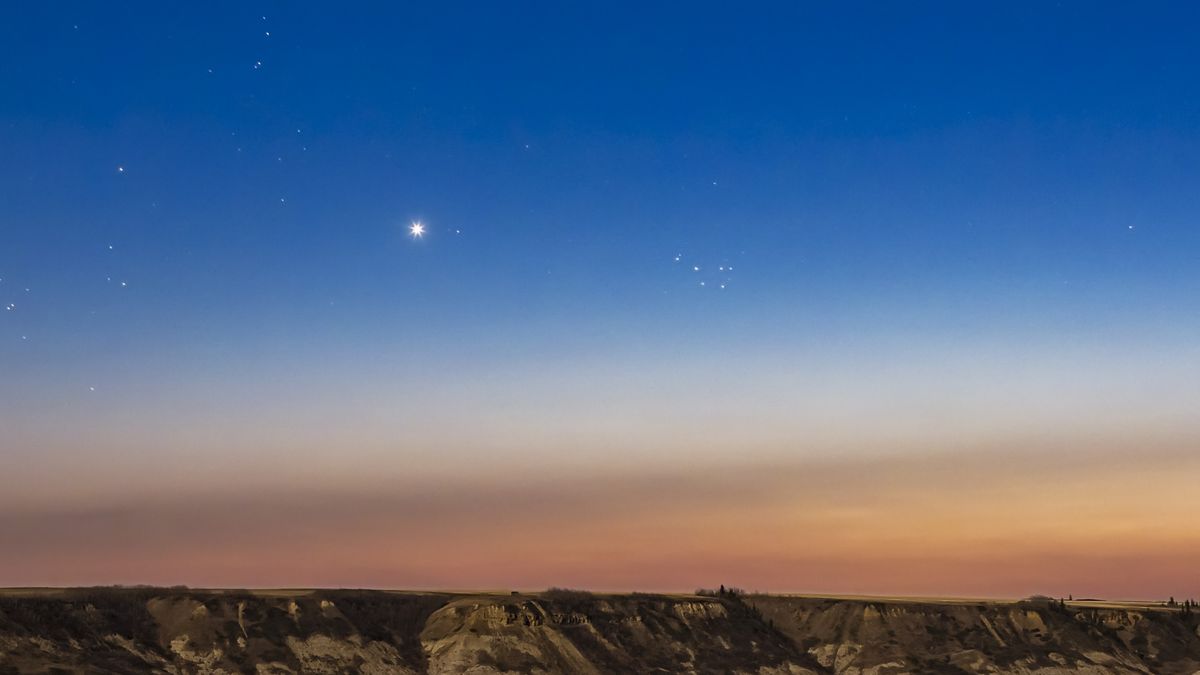NASA's James Webb Space Telescope (JWST) has produced a new image of the Bullet Cluster, which is a titanic collision between two individual galaxy clusters.
The image, produced in conjunction with NASA's Chandra X-ray Observatory, reveals not only the location and mass of dark matter present, but also points the way toward one day figuring out what dark matter is actually made of.
In the new image, we see the hot gas within the Bullet Cluster in false-color pink, detected by Chandra. The inferred location of dark matter is represented in blue (also false color), as measured by the JWST. Note that the blue and the pink are separate — what has caused the dark matter and the gas to separate, and how were astronomers able to produce this map of the material within the Bullet Cluster?
Located 3.9 billion light-years away, the Bullet Cluster has been an occasionally controversial poster child for dark-matter studies. Back in 2006, the Hubble Space Telescope and the Chandra X-ray Observatory worked together to image the Bullet, showing the presence of its dark matter based on how light from more distant galaxies was being gravitationally lensed by the dark matter's mass.
Collisions between galaxy clusters are the perfect laboratories for testing our ideas about dark matter, because they are nature's way of throwing together huge amounts of the stuff. This gives us a chance to test how dark matter particles interact with each other, if at all, and the degree of any interaction would be a huge clue as to the properties of the mysterious dark matter particle.
Yet despite the dramatic Hubble and Chandra images, the Bullet Cluster — and, indeed, other galaxy cluster collisions — haven't always played ball. For instance, the velocities at which the sub-clusters are colliding seem too high for the standard model of cosmology to explain.
Now the JWST has entered into the fray. A team led by Ph.D. student Sangjun Cha of Yonsei University in Seoul, South Korea, and professor of astronomy James Jee at both Yonsei and the University of California, Davis, have used the most powerful space telescope ever built to get a best-ever look at the Bullet Cluster.
Hubble and Chandra had previously shown that, as the two individual galaxy clusters in the Bullet Cluster collided, the galaxies and their surrounding dark matter haloes had passed right through each other. This makes sense for the galaxies — the distances between them are so great that the chance of a head-on collision between any two is slim. It also suggests that the degree with which dark matter particles interact with each other — what we refer to as their collisional cross section — is small; otherwise, the interaction would have slowed the clouds of dark matter down, and we would detect it closer to where Chandra sees the hot, X-ray emitting intracluster gas. In contrast to the dark matter, these huge gas clouds can't get out of each other's way, so they slam into each other and don't progress any further.
The end result is that the hot gas is found stuck in the middle of the collision, and the galaxies and dark matter belonging to each sub-cluster are found on opposite sides, having glided right through one another.
"Our JWST measurements support this," Jee told Space.com. "The galaxy distribution closely traces the dark matter."
JWST was able to produce a better map of the distribution of matter, both ordinary and dark, in the Bullet Cluster by detecting, for the first time, the combined glow from billions of stars that have been thrown out of their galaxies and are now free-floating in the space between the galaxies in each sub-cluster. Cha and Jee's team were then able to use the light from these "intracluster stars" to trace the presence of dark matter and gain a more accurate map of its distribution in the Bullet Cluster.
However, this has just raised more mysteries. The more refined map of the dark matter shows that, in the larger sub-cluster, on the left, the dark matter is arranged in an elongated, "hammerhead" shape that, according to Jee, "cannot be easily explained by a single head-on collision."
This elongated mass of dark matter is resolved into smaller clumps centered on what we call the brightest cluster galaxies — giant elliptical galaxies that are the brightest galaxies in the sub-cluster located at its gravitational core. In contrast, the dark matter halo around the sub-cluster on the opposite side is smaller and more compact.
Cha and Jee's team suspect that the elongated, clumpy mass of dark matter could only have formed when that particular sub-cluster, which was a galaxy cluster in its own right before the Bullet collision, underwent a similar collision and merger with another galaxy cluster billions of years before the formation of the Bullet.

"Such an event would have stretched and distorted the dark-matter halo over time, resulting in the elongated morphology that we observe," said Jee.
Despite the new discoveries such as this from JWST's more refined observations of the Bullet cluster, it is still not enough to resolve the issue of the collision velocities of the two sub-clusters.
"Even with these updates, the required collision velocity remains high relative to expectations from cosmological simulations," said Jee. "The tension persists and remains an active area of research."
Dark matter makes up over a quarter of all the mass and energy in the universe, and roughly 85% of all matter, so figuring out its secrets, in particular its collisional cross-section and the cause of those high velocities, is going to be essential if we want to better understand this universe in which we live.
Alas, the JWST observations of the Bullet Cluster alone are not enough to confirm what the collisional cross-section of dark matter must be. However, they do tighten the estimate of the upper limit for the value of the cross-section, constraining the list of possibilities.
Astronomers are already in the process of rigorously measuring as many galaxy cluster collisions as possible, seen from all angles and distances, to try and constrain this value further. Gradually, we'll be able to rule out different models for what dark matter could be, until we're left with just a few. Coupled with experimental data from direct dark matter searches from detectors deep underground, such as the LUX-ZEPLIN experiment at the Sanford Underground Research Facility in South Dakota, we could soon be on the cusp of answering one of science's greatest mysteries: what is dark matter?
The JWST observations were reported on June 30 in The Astrophysical Journal Letters.
.png)
 German (DE)
German (DE)  English (US)
English (US)  Spanish (ES)
Spanish (ES)  French (FR)
French (FR)  Hindi (IN)
Hindi (IN)  Italian (IT)
Italian (IT)  Russian (RU)
Russian (RU) 








Comments